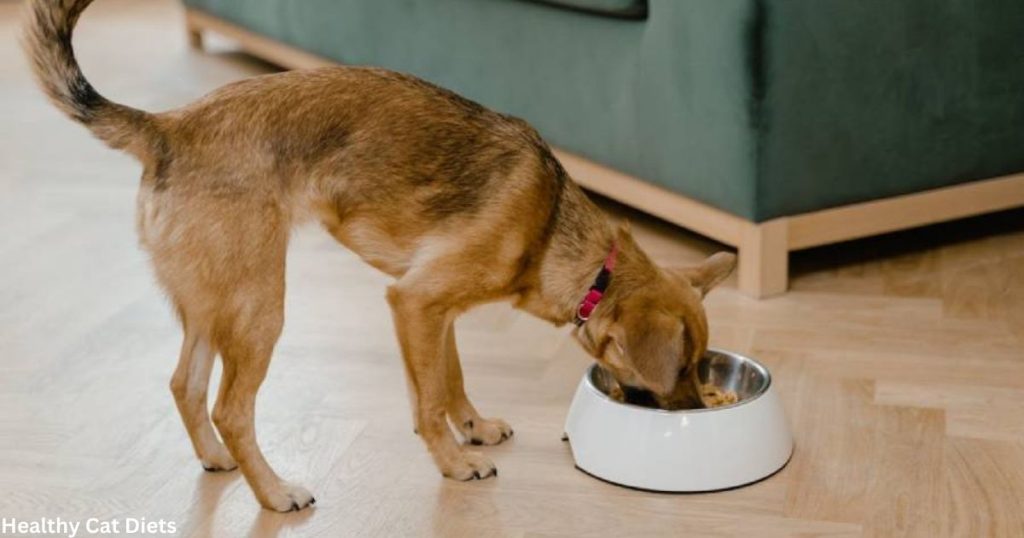Feeding your dog cat food may seem harmless, especially if they’re drawn to the smell or taste. However, it’s important to understand that cat food is specifically formulated for the dietary needs of cats, which are quite different from those of dogs. Dogs are omnivores, while cats are obligate carnivores, meaning they require certain nutrients that dogs can get from a more varied diet.
When a dog consumes cat food regularly, it can lead to a range of health issues, primarily due to its high protein and fat content. This imbalance can cause various health problems that may not surface immediately but can lead to serious long-term complications. Understanding these risks helps pet owners make informed choices about their pets’ diets.
What Happens If My Dog Eats Cat Food?
Overview of Immediate Effects
If a dog occasionally sneaks some cat food, they may not experience immediate adverse effects. However, the high-fat content can cause gastrointestinal upset, leading to vomiting or diarrhea. If the consumption is excessive or regular, the dog may experience more severe consequences.
Long-Term Health Risks
Over time, a diet high in cat food can increase a dog’s risk of serious health issues, including pancreatitis, which is inflammation of the pancreas. Symptoms include abdominal pain, lethargy, and a loss of appetite. Additionally, consistent consumption of cat food can contribute to obesity, which further exacerbates health problems, including joint issues and heart disease.
Health Issues from Eating Cat Food

High-Protein Health Risks
Pancreatitis: Causes and Symptoms
Pancreatitis is a significant risk for dogs that consume cat food regularly. The condition occurs when the pancreas becomes inflamed, often due to high-fat diets. Symptoms can include severe abdominal pain, vomiting, and lethargy. If you suspect your dog has pancreatitis, it’s essential to seek veterinary care immediately.
Liver Damage: What to Look Out For
A high-protein diet from cat food can also strain a dog’s liver over time. Liver damage may not show obvious symptoms at first, but signs like jaundice, increased thirst, and changes in appetite can indicate underlying issues. Regular veterinary check-ups can help monitor liver function and catch problems early.
Obesity: How Cat Food Contributes
The calorie-dense nature of cat food can lead to rapid weight gain in dogs, especially if they are less active. Obesity in dogs is linked to numerous health issues, including diabetes, joint problems, and a decreased lifespan. Owners should be vigilant about their dog’s weight and adjust feeding practices accordingly.
Kidney Problems: The Long-Term Effects
A high-protein diet can also put stress on a dog’s kidneys. Over time, this can lead to chronic kidney disease, particularly in older dogs. Symptoms include increased thirst and urination, weight loss, and poor coat condition. Regular monitoring and a balanced diet can help mitigate these risks.
Dog Behavior and Cat Food
Why Does My Dog Prefer Cat Food?
Taste and Aroma Differences
One reason dogs may prefer cat food is its strong aroma and rich taste, which can be more appealing than typical dog food. Cat food often contains higher levels of fats and proteins, making it more enticing. Dogs, being opportunistic eaters, are likely to gravitate toward what smells and tastes better to them.
Behavioral Factors Influencing Preference
Dogs may also show a preference for cat food due to curiosity or the desire to compete with cats for food. If they see a cat enjoying their meal, they may want to try it for themselves. This behavior can be exacerbated if the dog has had limited exposure to different types of food, leading them to be more adventurous in their eating habits.
You Also Like It:
How Much Dry Food to Feed a Cat Per Day
How Much Wet Food Should a Cat Eat a Day
How Much Wet Food to Feed a Cat
Feeding Practices and Recommendations
Can I Mix Cat Food with Dog Food?
Pros and Cons of Mixing
Mixing cat food with dog food can be tempting, but it’s generally not recommended. While it might seem like a way to entice a dog to eat, the nutritional imbalance can lead to health issues. The high protein and fat levels in cat food can upset the dietary balance dogs need, potentially leading to the health issues discussed earlier.
Guidelines for Safe Feeding
If you must mix cat food with dog food, do so sparingly and ensure it doesn’t make up more than a small percentage of your dog’s overall diet. Consult with your veterinarian to establish a feeding plan that meets your dog’s specific nutritional needs while avoiding potential hazards.
What to Do If Your Dog Eats Cat Food
Immediate Steps to Take
If your dog has eaten cat food, observe them closely for any signs of distress. Watch for vomiting, diarrhea, or signs of pain. If the consumption was excessive, contact your vet for advice on what to do next.
When to Consult a Veterinarian
If your dog shows any concerning symptoms after eating cat food or if they have consumed a large quantity, it’s important to seek veterinary help. Early intervention can prevent more serious health problems down the line.
Conclusion About Is Cat Food Bad for Dogs
Key Takeaways
In summary, while cat food may not pose an immediate threat to dogs, it can lead to significant health risks when consumed regularly. Understanding the nutritional differences between dog and cat food is essential for maintaining your dog’s health. Be aware of their eating habits, and always consult your veterinarian if you have concerns about their diet. A balanced diet tailored to your dog’s needs is crucial for their long-term well-being.
You Also Like It: